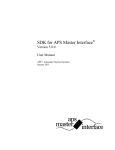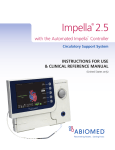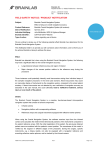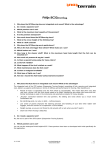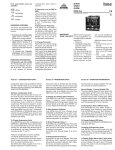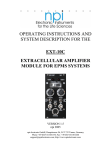Download User`s Manual - Gray Matter Research
Transcript
The Deep Vertical Microdrive (SC32-1DV), assembly and loading instructions. Coarse manipulator Headpost Connecting Rod Microdrive/Insert assembly Headpost Cranial rapid prototype Figure 1. The Deep Vertical Microdrive (SC32-1DV) mounted onto a vertical recording chamber and rapid prototype of a monkey’s skull. Gray Matter Research, Inc. – www.graymatter-research.com The Deep Vertical Microdrive (SC32-1DV) enables the implantation and independent manipulation of 32 microelectrodes at depths greater than 20 mm. To accomplish this the microdrive is coupled to a coarse manipulator system that allows all of the electrodes to be slowly advanced into the brain in one step. This procedure places the tips of the electrodes at the starting position lying above the intended target structure. Once this is completed, the coarse manipulator is removed and the microdrive is fixed in place. Following this procedure, the electrodes can be advanced independently at the user’s discretion using the precision control provided by the microdrive. The electrodes are intended to remain in the brain for prolonged periods and small changes in electrode position can be used to record new activity. When not in use, the system is covered by a protective Titanium cap. The following pages illustrate the sequence of steps for assembly of the system and the loading of the electrodes. The adjacent photograph (Fig.1) shows a fully assembled system mounted onto a plastic model of a monkey’s skull (rapid prototype, reconstructed from an MRI scan) that is held in place with a head holder system. This illustrates the system as it would appear just prior to lowering all of the electrodes into the brain using the coarse manipulator. 1 Microdrive and Coarse Manipulator Parts 1) 1/16" x 2-56 set screw 2) Guide Rod 3) 1/4" x 1.2 unm machine screw 4) 0.16" x 1.2 unm machine screw 5) 0.12" x 0.8 unm machine screw 6) Printed Circuit Board 7) Plungerblock Bottom 8) Chamber Insert 9) Plungerblock Top 10) Screw Guide 11) Coarse Actuator 12) Coarse Clamp 13) Thumb Wheel 14) Fastening Ring Figure 2. Components of the SC32-1DV microdrive system. Actuator components are not shown. Gray Matter Research, Inc. – www.graymatter-research.com 2 Assembly of plungerblock , chamber insert and guide rods 1 plungerblock 2 2-56 set screw guide rod insert Step 1: Mount plungerblock assembly (i.e. top and bottom plungerblock components) into the chamber insert. Be sure that the actuator holes in the plungerblock assembly are aligned with those in the chamber insert. 3 Step 3: Repeat step 2 until all 4 guide rods are mounted and the set screws are tight. Mount remaining 4 set screws into the plungerblock but do not tighten these screws. Step 2: Mount each guide rod through the alignment holes in the plungerblock and chamber insert. Be sure that the bottom surface of the guide rod does not extend beyond the bottom surface of the insert flange. Gently tighten 2-56 set screw. 4 Step 4: Retract plungerblock to top position of the guide rods then gently tighten set screws. Be sure that the top surface of the guide rods are flush with the top surface of the plungerblock. Figure 3. Steps for assembling the microdrive onto the chamber insert and guide rods. Gray Matter Research, Inc. – www.graymatter-research.com 3 Assembly and loading of the SC32 microdrive The SC32-1 utilizes a screw-driven mechanism to bi-directionally control electrode position along a single axis (Fig.4). Each actuator consists of a lead screw, an eccentric brass shuttle and a compression spring. The uninsulated end of each electrode is bonded to a shuttle using a conductive epoxy and the electrode/shuttle assembly is loaded into the microdrive using a multistep sequence (Fig.6, next page). When the device is assembled, electrode position is controlled by rotation of the lead screw (Fig.5), which causes the shuttle, and the electrode to which it is bonded, to translate. Counter clockwise rotation of the lead screw causes the electrode to advance and clockwise rotation causes the electrode to retract. The movement resolution is 8 turns/mm or 125 μm for each full 360º rotation of the screw. The design drawing shown in figure 4 illustrates the arrangements between the actuator components and the body of the microdrive. When assembled, the lead screw passes through the PCB and the lower, unthreaded portion of the screw fits into a blind hole in the bottom component of the actuator block. This configuration stabilizes the vertical alignment of the screw. The flange on the lead screw makes contact with the top, conductive surface on the PCB and the compression spring applies a constant downward pressure on the flange to insure that stable contact between the screw and the PCB is maintained when the screw guide is mounted. Electrical connection is mediated by contact from the electrode to the shuttle, to the lead screw, to the PCB, to the PCB connector. Figure 4. Cross-sectional view of the design drawing of the microdrive actuator illustrating the relationships among the components. Figure 5. Correct use of the precision screwdriver. The screwdriver used to the control the actuator is very delicate and must be used with care and proper alignment. A,B. These design drawings depict the correct alignment between the screwdriver blade and the lead screw. C. When the two parts are misaligned the screwdriver blade will rest on the top surface of the lead screw. In this position, a small gap will be apparent between the screwdriver and the top surface of the screw guide. Gray Matter Research, Inc. – www.graymatter-research.com 4 Assembly and loading of the SC32 microdrive Figure 6. Design drawings of a mock actuator illustrating the sequence of steps for assembly and loading of the microdrive prior to implantation. Operations 2-11 should be performed while the plungerblock is firmly mounted in the holder. Step 1: Assemble the bottom and top components of the plungerblock. Step 2: Insert the polyimide tubes from below into each hole of the plungerblock bottom until they are visible from the top surface. Step 3: Front load each electrode into the polyimide tubes. Step 4: Advance each shuttle into the plungerblock until it is flush with the top surface of the plungerblock. Step 5: Mount the PCB on the plungerblock. Step 6: Advance the lead screw through the PCB and ‘catch’ the threads on the shuttle. Rotate the lead screw to retract the shuttle onto the shaft of the screw. Step 7: Advance the lead screw into the microdrive until the flange on the screw sits flush against the top surface of the PCB. Step 8: Mount the compression spring onto the shank of the lead screw. Step 9: Mount the screw guide over the exposed screws/springs and tighten down to the PCB. Step 10: Remove the polyimide tubes from the bottom of the drive. Step 11: Retract each electrode by clockwise rotation of the lead screw. Once the tip of the electrode is no longer visible, continue retraction an additional 0.5 mm. This keeps the electrode tips retracted within the drive and protected. Gray Matter Research, Inc. – www.graymatter-research.com 5 Loading microelectrodes into the plungerblock/insert assembly (Figures 7-9) 1 holder plungerblock 2-56 set screw insert Step1: Mount plungerblock/insert assembly into holder, tighten holder, then rotate to a horizontal orientation. guide rod Step 2: Backload PI tubing through each hole in the insert. 2 PI tube Figure 7. Gray Matter Research, Inc. – www.graymatter-research.com 6 Loading microelectrodes into the plungerblock/insert assembly (Figures 7-9) 3 Step 3: Thread PI tubing into corresponding hole in the plungerblock. 4 Step 4: Front load the electrode/shuttle assembly into the PI tube. electrode/shuttle assembly Figure 8. Gray Matter Research, Inc. – www.graymatter-research.com 7 Loading microelectrodes into the plungerblock/insert assembly (Figures 7-9) 5 6 Step 5: Advance electrode/shuttle assembly through PI tube until the top surface of the shuttle is flush with the top surface of the plungerblock (not shown). Step 6: Remove PI tubing from below the bottom of the chamber insert, leaving electrode/shuttle assembly in place. Figure 9. Gray Matter Research, Inc. – www.graymatter-research.com 8 Completion of microdrive assembly prior to mounting into chamber (Figures 10-13) Figure 10. 1 plungerblock 2 PCB shuttle 2-56 set screw guide rod holder insert Step 1: Once all electrode/shuttle assemblies are loaded into the microdrive, reorient the full assembly to a vertical position. Gray Matter Research, Inc. – www.graymatter-research.com Step 2: Mount the PCB onto the top surface of the plungerblock using the two 0.16" x 1.2 unm machine screws. 9 Completion of microdrive assembly prior to mounting into chamber (Figures 10-13) Figure 11. 3 4 lead screw gap Step 3: Advance each lead screw through one of the holes in the PCB until the screw rests on the shuttle. Gray Matter Research, Inc. – www.graymatter-research.com Step 4: Rotate the lead screw manually until it catches the threads of the shuttle. Rotate the screw approximately 50 turns to raise the shuttle up the shaft of the lead screw. Advance the lead screw into the microdrive. 10 Completion of microdrive assembly prior to mounting into chamber (Figures 10-13) Figure 12. 5 6 compression spring Step 5: Advance lead screw until it seats flush against the top surface of the plungerblock. Gray Matter Research, Inc. – www.graymatter-research.com Step 6: Mount a compression spring over the shaft of the lead screw. Repeat steps 3-6 until all 32 screws and springs are loaded. 11 Completion of microdrive assembly prior to mounting into chamber (Figures 10-13) Figure 13. 7 Step 7: Mount the screw guide over the lead screws and compression springs. Be sure that all screws and holes are aligned. Gray Matter Research, Inc. – www.graymatter-research.com 8 Step 8: Fasten the screw guide tight against the PCB by incrementally tightening each screw in succession to avoid any tilting of the screw guide. 12 Sealing the microdrive to prevent fluid backflow 1 3 Step 1: Once electrode loading and assembly is complete, rotate the holder so that the microdrive is upside down. Step 3: Gently press the silicone grease into the holes using a spatula. Repeat this step multiple times until the majority of the grease has been pressed into the holes. 2 4 Step 2: Place a small amount of silicone grease onto the bottom surface of the insert. Step 4: Gently wipe off the excess silicone grease from the bottom surface of the insert. Be sure to remove all grease from the sides of the insert as well. Figure 14. Filling of the guide holes in the insert with silicone grease. Gray Matter Research, Inc. – www.graymatter-research.com 3 Sealing the microdrive to prevent fluid backflow 1 3 Step 5: Carefully remove all excess silicone grease from the bottom surface of the chamber insert. Step 7: Gently move the sealant around the bottom surface of the insert until the entire surface is covered with a uniform layer of the sealant. 2 Step 6: Apply a small amount of the silicone sealant to the bottom surface of the insert. 4 Step 8: Allow the sealant to cure for 24 hours. Figure 15. Sealing the bottom surface of the microdrive insert with silicone sealant. Gray Matter Research, Inc. – www.graymatter-research.com 3 Mounting of vertical chamber to rapid prototype of skull. Figure 16. This figure illustrates the mounting of the vertical chamber onto a plastic model (rapid prototype) of a monkey’s skull. 1 Step 1: Perform craniotomy and mount bone screws around perimeter. 2 Step 2: Position chamber and insert within craniotomy. Gray Matter Research, Inc. – www.graymatter-research.com 3 Step 3: Fix chamber to skull using acrylic bone cement. 13 Mounting microdrive/insert assembly onto the recording chamber (Figures 17-27) Figure 17. 1 Step 1: Position skull model so that the chamber is vertically oriented. Gray Matter Research, Inc. – www.graymatter-research.com 2 Step 2: Mount O-ring (red) within the groove on the top surface of the chamber. 14 Mounting microdrive/insert assembly onto the recording chamber (Figures 15-27) Figure 18. 3 Step 3: Mount the plungerblock/insert assembly onto the chamber, using the pin on the top of the chamber as a guide. Gray Matter Research, Inc. – www.graymatter-research.com 4 Step 4: Mount the cap screws into the holes on the top surface of the insert. Use care during this step to avoid dropping the screws into the insert. If this occurs it may be necessary to remove the assembly from the chamber to retrieve the screw(s). 15 Mounting microdrive/insert assembly onto the recording chamber (Figures 15-27) Figure 19. 5 Step 5: Tighten all of the cap screws onto the chamber using the round-head hex wrench. Gray Matter Research, Inc. – www.graymatter-research.com 6 Step 6: Mount the coarse manipulator onto the chamber. 16 Mounting microdrive/insert assembly onto the recording chamber (Figures 15-27) Figure 20. 7 Step 7: Tighten the fastening ring onto the chamber and position the holder (black) over the microdrive. Gray Matter Research, Inc. – www.graymatter-research.com 8 Step 8: Advance the coarse manipulator until the holder makes flush contact with the top of the microdrive. Then tighten the holder. 17 Mounting microdrive/insert assembly onto the recording chamber (Figures 15-27) Figure 21. 9 Step 9: Loosen the set screws at the top of the guide rods. Gray Matter Research, Inc. – www.graymatter-research.com 10 Step 10: Slowly advance the microdrive using the coarse manipulator. 18 Mounting microdrive/insert assembly onto the recording chamber (Figures 15-27) Figure 22. 11 Step 11: Slowly advance the microdrive using the coarse manipulator. Gray Matter Research, Inc. – www.graymatter-research.com 12 Step 12: Slowly advance the microdrive using the coarse manipulator. 19 Mounting microdrive/insert assembly onto the recording chamber (Figures 15-27) Figure 23. 13 Step 13: Mount the cap screws into the plungerblock that are used to fasten the plungerblock to the chamber. Gray Matter Research, Inc. – www.graymatter-research.com 14 Step 14: Tighten the cap screws into the plungerblock. 20 Mounting microdrive/insert assembly onto the recording chamber (Figures 15-27) Figure 24. 15 Step 15: Loosen the holder on the coarse manipulator and begin to retract the coarse manipulator. Gray Matter Research, Inc. – www.graymatter-research.com 16 Step 16: Retract the coarse manipulator. 21 Mounting microdrive/insert assembly onto the recording chamber (Figures 15-27) Figure 25. 17 Step 17: Retract the coarse manipulator. Gray Matter Research, Inc. – www.graymatter-research.com 18 Step 18: Remove the coarse manipulator. 22 Mounting microdrive/insert assembly onto the recording chamber (Figures 15-27) Figure 26. 19 Step 19: Loosen the set screw holding the guide rods in place then remove the guide rods. Gray Matter Research, Inc. – www.graymatter-research.com 20 Step 20: Remove the set screws that are used for holding the guide rods in place. 23 Mounting microdrive/insert assembly onto the recording chamber (Figures 15-27) Figure 27. 21 Step 21: Cover the assembly with the protective cap. Gray Matter Research, Inc. – www.graymatter-research.com 24



























